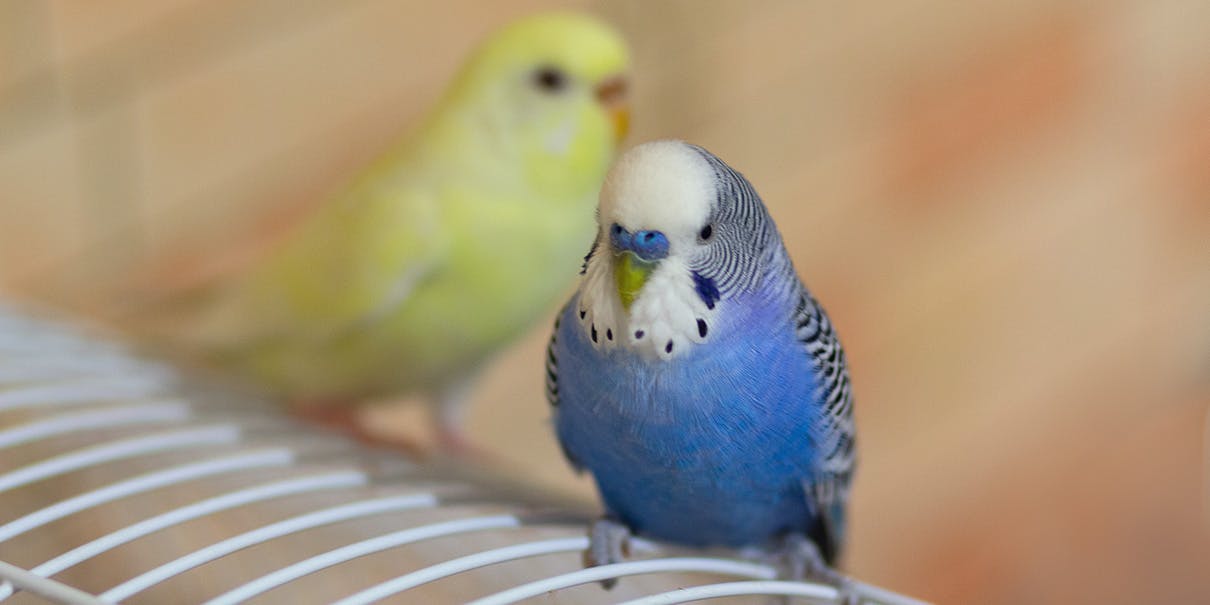
How To Care For Your Pet Budgie
Bird
Health and Wellbeing
General Advice
01/05/2023
The budgie is a small bird from the parrot family. They are native to Australia where they live in large flocks, travelling to wherever they can find food and water. In the wild, budgies’ natural colouring is green and yellow but in captivity breeders keep all sorts of colour variations, resulting in more than 100 recognised colour patterns. All the budgies for sale today are bred in captivity.
Budgies make great little pets because they are easy to care for and can become talented talkers and mimics. The average lifespan of a budgie is eight to 10 years, though it’s not unusual for budgies to live for 14 years, with some even making it to 20 years old! To ensure your budgie has a long and happy life, provide a clean cage, daily exercise, a healthy diet including fresh fruit and vegetables offered daily, and plenty of activity and companionship.
The cage
Budgies are extremely active and need to stretch their wings and have space for fluttering around their cage. For this reason, your budgie’s cage should be long rather than high in order to provide some room for flying. When considering cage size remember to take into account cage accessories eg. perches, seed and water dishes, toys, swings, and ladders, but do not clutter your budgie’s cage. To enable your budgie to climb around and get some exercise, ensure the cage has horizontal bars as well as vertical ones – don’t buy a cage with vertical bars only – and make sure it has a plastic removable tray at the bottom of the cage for easy cleaning.
Daily exercise
Regardless of your budgie’s cage size, in order for it to remain healthy and happy, it will need regular time out of its cage. Let your budgie out for a fly as often as possible – at least three times a week, but preferably daily. Ensure all windows and doors are closed, cover all windows and mirrors (as birds can’t see glass) and keep other pets out of the room. The minimum time out should be one hour per day, but ideally your budgie should be able to come and go as it pleases, within reason, and depending on your home environment. Do not keep your budgie locked up in its cage day in and day out.
A healthy diet
High-quality budgie seed mix should make up about 70% of your bird’s diet. These are readily available at pet shops and supermarkets. Don’t buy the seed in bulk – instead, purchase small fresh packets. Budgies enjoy spray millet and seed treats such as honey bells or sticks. However, these are fattening and treats should only be offered once a week if your budgie is fairly active, or only once a fortnight if not as pet budgies can easily become overweight. Fresh daily drinking water is a must. Also, make available cuttlebone, calcium, mineral blocks, and fresh fruit and vegetables.
Amusement
Give your budgies plenty of toys, but nothing with shiny surfaces as it will see another budgie and want to play with it instead of you! Olympic rings, ladders, bells and birdbaths make good toys . Your local pet shop should have a wide selection and give advise on how to set them up.
Companionship
As budgies live in flocks they have a need for social activities. This means that unless you are home most of the time and are able to give your budgie regular time out of its cage to interact with you, you should get another budgie for companionship.
Safe food list
The following is a selection of fruit, vegetables and other food that you can give your budgie. Fresh food should be rinsed in cold water first.
- Apples (no pips)
- Apricots
- Broccoli
- Brussels sprouts
- Cabbage
- Carrots
- Cauliflower
- Chickweed
- Corn
- Peaches
- Pears (no pips)
- Puha
- Silver Beet
- Prohibited food list
Never feed your budgie the following:
- Alcohol
- Avocado
- Caffeine
- Chocolate
- Fruit Seeds
- Lettuce
- Rhubarb
- If in doubt about a food don’t feed it!
- Health check
Signs of illness to watch out for:
- abnormal breathing
- bleeding
- discharge from the beak, eyes or nostrils
- drooping head, tail or wings
- excessive feather picking or plucking
- falling off the perch
- fluffed-up appearance
- hunched-over posture
- loss of appetite
- sitting on the bottom of the cage
- untidy appearance
- vomiting
- weight loss
NB: This guide only covers some health issues. If you are concerned about your budgie’s health, consult your vet for advice.